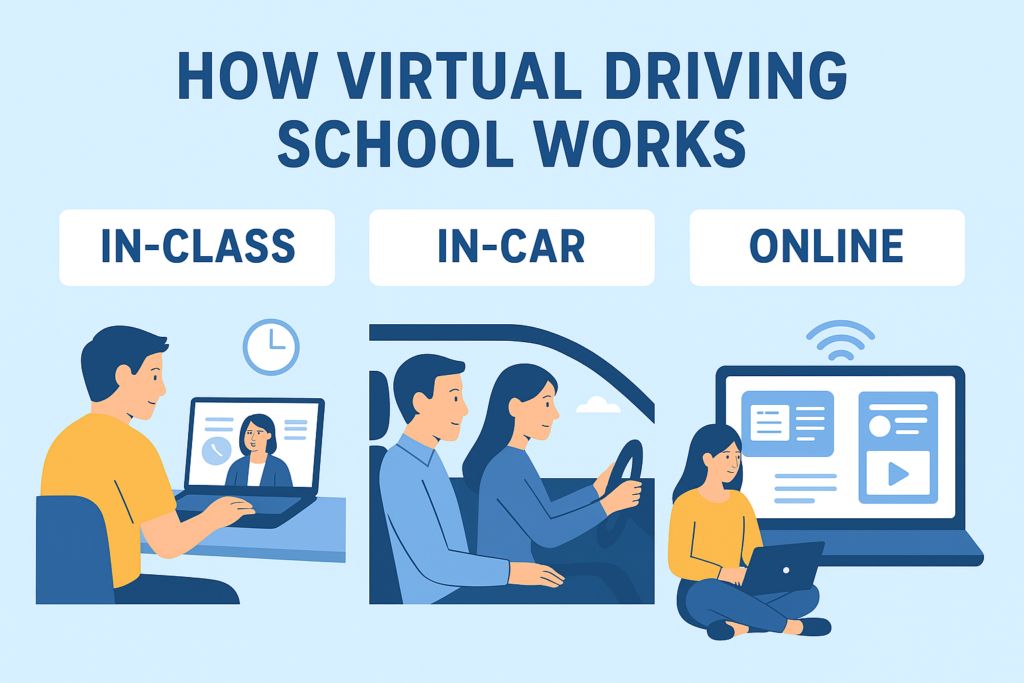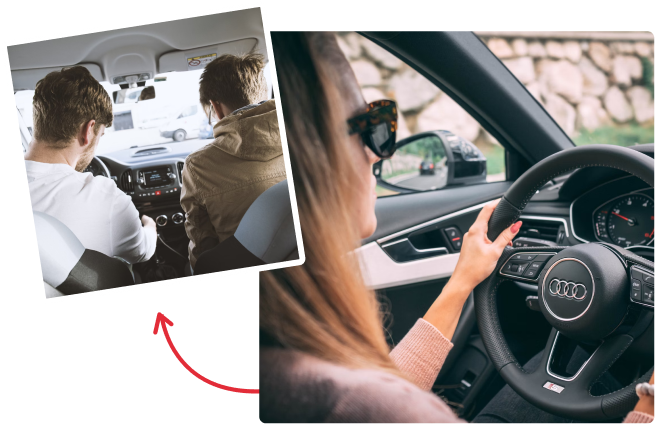As the world becomes increasingly digital, the way we learn essential life skills, like driving, is evolving too. Today’s learner drivers have more options than ever before, thanks to the rise of virtual driving school programs. Whether you’re preparing for your G1 knowledge test, working toward your G2 road test, or simply brushing up on your skills, virtual learning offers unmatched flexibility without compromising quality.
In this guide, we’ll break down how virtual driving school works, the differences between in-class, in-car, and online learning, and why this blended approach is becoming the preferred choice for new drivers.
What Is a Virtual Driving School?
A virtual driving school is a modern version of traditional driver education, where students complete part or all of their learning through online platforms. Instead of attending physical classrooms every week, students access interactive lessons, videos, quizzes, and instructor-led virtual sessions from the comfort of their own homes.
Many government-recognized driving schools now offer virtual programs that meet all Ministry of Transportation (MTO) or state requirements. This ensures students receive high-quality instruction while enjoying the convenience of online learning.
How Virtual Driving School Works
A standard driver education program typically consists of three main components:
-
In-Class Training (Theory learning)
-
In-Car Training (Behind-the-wheel practice)
-
Online Learning (Interactive modules and virtual classrooms)
Here’s how each part functions—and how they fit together in a virtual driving school setting.
1. Virtual In-Class Training: Learn the Theory Online
Traditional in-class sessions are now delivered through live virtual classrooms or self-paced online modules. The goal is the same: to teach the rules of the road, defensive driving strategies, safety awareness, and decision-making behind the wheel.
What Virtual In-Class Training Includes
-
Live instructor-led classes via Zoom or learning platforms
-
Digital presentations and interactive slides
-
Videos demonstrating real-world driving scenarios
-
Quizzes and tests for progress tracking
-
Discussions and Q&A sessions with experienced instructors
Benefits of Virtual In-Class Training
-
Attend from anywhere—home, office, library
-
Flexible scheduling
-
No commute or classroom distractions
-
Ability to revisit recorded sessions
-
Higher engagement through interactive content
For learners with busy schedules, virtual in-class training is a game-changer. It maintains the same structure as classroom learning but adds more convenience and flexibility.
2. In-Car Training: Hands-On Learning with a Professional Instructor
No driving program is complete without actual behind-the-wheel training. While the in-class portion can be done virtually, the in-car lessons must be completed in person.
How In-Car Training Works
-
Certified instructors pick the student up from a selected location
-
Lessons follow an MTO-approved curriculum
-
Step-by-step guidance on vehicle control, road rules, and safe driving
-
Real-world practice with turning, parking, highway driving, and intersections
-
Performance feedback after each lesson
Why In-Car Training Still Matters
Driving is a physical skill. Students need to:
-
Feel how a car responds
-
Learn real-time decision-making
-
Practice safe habits in real traffic environments
Virtual learning builds the foundation, while in-car lessons refine real-world skills.
3. Online Learning Modules: Self-Paced, Interactive & Engaging
Many virtual driving schools provide self-paced online modules that supplement the live virtual classroom sessions. These modules are designed to reinforce learning and help students prepare for their road tests.
What’s Inside Online Modules?
-
Simulation videos
-
Road sign tutorials
-
Animated driving scenarios
-
Defensive driving tips
-
Knowledge test practice questions
-
Case studies from real accident situations
Benefits of Online Modules
-
Learn at your own speed
-
Pause, replay, and review concepts anytime
-
Boosts knowledge retention
-
Perfect for G1 and G2 test preparation
In-Class vs In-Car vs Online: Which Is Best for You?
Each learning method plays a unique role:
Virtual In-Class
Best for:
✔ Students who prefer structured lessons
✔ Those preparing for G1/G2 exams
✔ Learners who want instructor interaction
✔ Busy students needing flexible schedules
Online Modules
Best for:
✔ Fast learners who like self-paced study
✔ Students who want extra practice
✔ Visual learners who enjoy videos and animations
✔ Those who need anytime access to lessons
In-Car Practical Lessons
Best for:
✔ Mastering real-world driving
✔ Learning complex maneuvers
✔ Developing muscle memory
✔ Building confidence behind the wheel
A complete virtual driving school blends all three—giving students a well-rounded, modern learning experience.
Why Virtual Driving School Is Becoming So Popular
More students (and parents) are choosing virtual programs because they offer:
✔ More Flexibility
Study at home, on vacation, or between school and work.
✔ Lower Stress
Learners feel more comfortable asking questions online.
✔ Better Learning Tools
Digital quizzes, interactive videos, and online assessments improve retention.
✔ Safety & Convenience
No need to travel to a classroom; perfect for busy schedules.
✔ High Success Rates
Students who combine virtual learning with strong in-car training often perform better on road tests.
Virtual programs maintain the same standards as in-person classes—just with more convenience and engagement.
Frequently Asked Questions (FAQs)
1. Is virtual driving school approved by the government?
Yes. Many schools offering virtual programs are fully approved by the Ministry of Transportation (MTO) or local state departments. Always check if the school is certified before enrolling.
2. Do online classes cover everything needed for my G1 or G2?
Yes. Virtual in-class and online modules cover theory, rules of the road, defensive driving, and test preparation.
3. Can I finish all parts of driving school online?
No. The theoretical portions can be online, but in-car training is required in person with a certified instructor.
4. Are virtual classes as effective as in-person classes?
Absolutely. In many cases, students find virtual classes more engaging due to interactive activities and flexibility.
5. Do online driving courses lower insurance rates?
Yes—if the school is MTO-approved. Certified completion often qualifies students for insurance discounts.
Conclusion: Ready to Start Your Virtual Driving School Journey?
A virtual driving school offers a perfect balance of convenience, flexibility, and high-quality instruction. With a combination of online learning, virtual classrooms, and in-car training, students receive the full driver education experience—without sacrificing comfort or effectiveness.
If you’re ready to begin your journey toward becoming a safe, confident driver, now is the perfect time to enroll.
Start your virtual driving school program today and take the first step toward getting your license with confidence!





